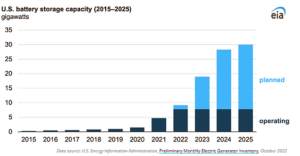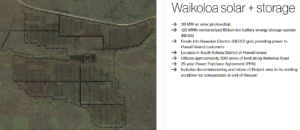Hawaii’s Energy Future has Arrived
The energy future that we’ve long been waiting for is here. Let’s take advantage of it.
We’ve known for decades that we should reduce the burning of fossil fuels and other materials to generate energy because of their harmful by-products on climate, health, and the global environment. We’ve also known that solar, wind, and other clean and renewable sources are better energy options, but they were more expensive compared to most legacy energy systems.
Change is the great arbiter and in comes many forms. In this case it came in the form of new technology, Federal policy, and market forces each working to bring down the costs of clean and renewable energy. Many of us have been waiting, and now the costs of solar and wind and battery storage have been reduced to such an extent that they are currently the least expensive and most equitable forms of energy now powering utility grids.
 Although macroeconomic and supply chain issues influence costs, the overall cost of PV solar and battery storage continues to drop with technology and manufacturing improvements. and efficiency advancements. New energy projects pairing solar with battery storage are being built across the nation. A number of them are located in Hawaii, and more are being planned.
Although macroeconomic and supply chain issues influence costs, the overall cost of PV solar and battery storage continues to drop with technology and manufacturing improvements. and efficiency advancements. New energy projects pairing solar with battery storage are being built across the nation. A number of them are located in Hawaii, and more are being planned.
Reliable, resilient, and clean (zero emissions) renewable energy options continue to drive down electricity costs for ratepayers. Batteries now are now fulfilling the role as on-demand firm energy assets, once the exclusive domain of expensive to build, operate, and polluting combustion-based power plants.
The recently enacted Inflation Reduction Act (IRA) is projected to drive nearly $3.5 trillion in the Federal government investment of new energy supply and infrastructure onto the grid, the majority of which will be intermittent renewable resources backed by batteries. The ICF Climate Center estimates IRA incentives could drive down the cost of solar energy by as much as 35% and wind by as much as 49% by 2030. The potential beneficiaries of the IRA financial incentives include Hawaii’s residents and ratepayers, businesses, and Hawaiian Electric, the state’s largest and publicly-traded utility.
Often missing in the discussion of Hawaii’s transition to a clean energy economy are the direct and quantifiable benefits this transition is contributing to the state’s economy. Certainly, lowering the cost of energy production should translate into lower utility fees for consumers, but that is just one example of the direct economic benefits to the state.
Clean energy projects by themselves are significant contributors to the state’s economy and climate goals, as exemplified by the recent AES Solar + Storage project on Hawaii Island. This one project will not only deliver unprecedented low cost clean energy to HELCO at $0.09 per kWh, but according to AES has produced 200 jobs and generated a total economic benefit for Hawai‘i’s local economy estimated upwards to $47 million. This one solar project also is expected to replace over one half million barrels of imported oil annually, while meeting the over 7% of the electricity needs for Hawaii Island.
 Hawaii is by no means standing still when it comes to clean and renewable energy. Hawaii’s 100% renewable mandate by 2045 for energy powering the state’s two utilities may be a ways out, but challenges remain on the road to Hawaii’s 21st century clean energy economy. The good news is as a state we are moving forward.
Hawaii is by no means standing still when it comes to clean and renewable energy. Hawaii’s 100% renewable mandate by 2045 for energy powering the state’s two utilities may be a ways out, but challenges remain on the road to Hawaii’s 21st century clean energy economy. The good news is as a state we are moving forward.
In total, recent solar projects in Hawaii demonstrate an encouraging trend and progress, including; the Lawai Solar and Energy Project on Kauai, which was at the time the largest solar plus storage peak-power generator in the world. It combines 28 megawatts of solar photovoltaic capacity with lithium-ion batteries capable of storing 100 megawatt-hours, while delivering electricity on demand at only 11 cents per kilowatt-hour. The average electricity rate for Hawaiian Electric throughout the state (excluding Kauai) ranges from 38 cents to the current high of 44 per kilowatt-hour for Hawaii Island residents.
Mililani Solar I is another example, located on former sugar-cane fields inland from Pearl Harbor, generates 39 megawatts of solar power for only 9 cents per kilowatt-hour. Other completed and low cost solar projects include Kawailoa Solar in Haleiwa, the Waianae Solar Project, Waiawa Solar Power, and Kauai Solar. Other solar projects in the works across the state include:
- For Kauai, there is innovative West Kauai Solar Energy Project, the first integrated pumped storage hydropower, solar and battery project of its kind in the world.
- Oahu: Kaukonahua Solar, AES West Oahu, Hoohana Solar 1, Kapolei Energy Storage, Kupono Solar, Mountain View Solar, Waiawa Phase 2 Solar, Kalaeloa Home Lands Solar, and Palailai Solar.
- Molokai: Kualapua Solar and Palaau Solar.
- Lanai: Lanai Solar Project.
- Maui: Lipoa Solar, Makawao Solar, Piiholo Road Solar, Waena Battery Energy Storage, AES Kuihelani, Kamaole Solar, and Paeahu Solar.
- Hawaii Island: Kalaola Solar A and B, Naalehu Solar, Keahole Battery Energy Storage, Hale Kuawehi Solar, AES Waikoloa Solar
While solar power brings down costs for both utilities and ratepayers, the pairing of battery storage with solar panels turns this once intermittent clean electricity source into a reliable and on-demand power asset better suited to the uncertainties of a changing climate than traditional combustion power plants. Facilities that generate electricity by burning fossil fuel — or any other form of dirty energy combustion are increasingly costly and obsolete, and the sooner they are replaced the greater the public benefits. After all, consumers benefit from lower electricity rates, and the environment benefits from fewer greenhouse gas emissions is a win-win solution for the planet, humans, and the economy.
Clean, renewable energy is the future, and the future is here. It’s time we fully embrace it.
Special thanks to members John Kawamoto, Melodie Aduja, and Mark Koppel of Hawaii’s Clean Power Task Force for their contributions to this article. And mahalo a nui loa to the Honolulu Star Advertiser for co-publishing this article; February 21, 2023, Island Voices section.




Leave a Reply
Join the Community discussion now - your email address will not be published, remains secure and confidential. Mahalo.